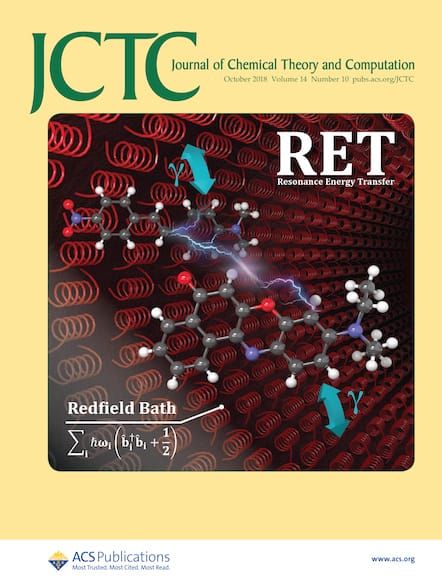NN-VRCTST: Neural Network Potentials Meet Variable Reaction Coordinate Transition State Theory for the Rate Constant Determination of Barrierless Reactions.
IF 5.5
1区 化学
Q2 CHEMISTRY, PHYSICAL
引用次数: 0
Abstract
The determination of rate constants for barrierless reactions poses severe problems from a theoretical perspective. The main challenges concern the proper description of the electronic structure of the reacting system, which may have multireference character, the anharmonicity of the relative motions of the fragments, and the proper definition of the reaction coordinate. The literature state of the art in the context of transition state theory is its variable reaction coordinate implementation (VRC-TST), which overcomes these difficulties in determining the number of transition state ro-vibrational states through a Monte Carlo sampling of the potential energy surface (PES) defined by the relative orientation of the two fragments. Although approaching the accuracy of experiments, VRC-TST requires tens of thousands of single-point energy (SPE) evaluations, thus being computationally demanding. The approach developed in this work, named NN-VRCTST, aims at fitting the PES with physics-inspired artificial neural network (ANN) models to be used as surrogate potentials in VRC-TST simulations. The ANN efficacy is evaluated in the computation of high-pressure limit rate constants for gas-phase barrierless reactions and validated over state-of-the-art VRC-TST simulations. It is shown that the NN-VRCTST tool reaches an accuracy within 20% with respect to VRC-TST simulations performed by using traditional approaches. While lowering the number of SPE needed by at least a factor of 4, the computational framework devised here allows one to decouple ANN training and VRC-TST calculations, enabling the optimization of the SPE evaluations as well as the quality inspection of the employed data points. We believe that the NN-VRCTST approach has the potential to evolve into a robust and computationally efficient framework for performing VRC-TST calculations for barrierless reactions.NN-VRCTST:神经网络势满足变反应坐标的过渡态理论确定无障碍反应的速率常数。
从理论上讲,确定无势垒反应的速率常数是一个严峻的问题。主要的挑战是如何正确地描述反应体系的电子结构(可能具有多参考特征)、碎片相对运动的非谐性以及反应坐标的正确定义。在过渡态理论的背景下,目前最先进的文献是它的变反应坐标实现(VRC-TST),它通过对由两个片段的相对取向定义的势能面(PES)进行蒙特卡罗采样,克服了确定过渡态反振动态数量的困难。VRC-TST虽然接近实验的精度,但需要数万次的单点能量(SPE)评估,因此计算要求很高。在这项工作中开发的方法,命名为NN-VRCTST,旨在用物理启发的人工神经网络(ANN)模型拟合PES,作为VRC-TST模拟中的替代电位。在气相无障反应的高压极限速率常数计算中评估了人工神经网络的有效性,并通过最先进的VRC-TST模拟进行了验证。结果表明,与传统方法进行的VRC-TST模拟相比,NN-VRCTST工具的精度在20%以内。虽然将所需的SPE数量降低了至少4倍,但这里设计的计算框架允许人们将ANN训练和VRC-TST计算解耦,从而优化SPE评估以及所使用数据点的质量检查。我们认为,NN-VRCTST方法有潜力发展成为一种鲁棒且计算效率高的框架,用于执行无障反应的VRC-TST计算。
本文章由计算机程序翻译,如有差异,请以英文原文为准。
求助全文
约1分钟内获得全文
求助全文
来源期刊

Journal of Chemical Theory and Computation
化学-物理:原子、分子和化学物理
CiteScore
9.90
自引率
16.40%
发文量
568
审稿时长
1 months
期刊介绍:
The Journal of Chemical Theory and Computation invites new and original contributions with the understanding that, if accepted, they will not be published elsewhere. Papers reporting new theories, methodology, and/or important applications in quantum electronic structure, molecular dynamics, and statistical mechanics are appropriate for submission to this Journal. Specific topics include advances in or applications of ab initio quantum mechanics, density functional theory, design and properties of new materials, surface science, Monte Carlo simulations, solvation models, QM/MM calculations, biomolecular structure prediction, and molecular dynamics in the broadest sense including gas-phase dynamics, ab initio dynamics, biomolecular dynamics, and protein folding. The Journal does not consider papers that are straightforward applications of known methods including DFT and molecular dynamics. The Journal favors submissions that include advances in theory or methodology with applications to compelling problems.
 求助内容:
求助内容: 应助结果提醒方式:
应助结果提醒方式:


